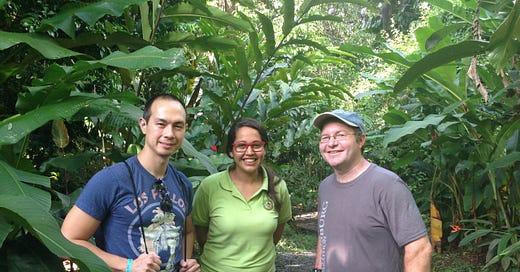5 Longevity Tips From a Centenarian Enclave
Discover why Costa Rica’s Nicoya Peninsula defies the limits of aging.
👋 Hello, I’m Kevin Ferguson, author of 🍷 Rain on the Monte Bello Ridge,🍷 my forthcoming memoir about health, aging and winemaking. (Read the origin story of the book.) 🍇 The Centenarian Playbook is my newsletter, which features longevity tips and stories from Grandma Kay’s long life. It also includes stories of the Gemello Winery, which her late husband, Mario, ran for nearly half a century. 📖 I’m sure you’ll find my maternal grandparents are quite lovable characters.
2014: My buddy Andreas (L) & I are pictured with our guide in the Costa Rican rainforest
5 Ways Nicoyans Tend to Live to Extreme Old Age
One of my favorite vacation destinations is Costa Rica. I’ve been there three times. This Central American country, sandwiched between Nicaragua and Panama, is known for its lush rainforests, swimmable waterfalls and volcanic-infused hot springs. What’s perhaps lesser known is that it is home to one of the world’s few centenarian enclaves.
This extreme longevity hub is located in the country’s northwest region called the Nicoya Peninsula, which includes an eighty-mile stretch of Pacific coastline. It’s one of the world’s five “blue zones,” defined as the world’s aging hot spots that have the highest concentration of centenarians.
The Nicoya Peninsula has three-and-a-half times more centenarians than the global average, according to Dan Buettner, longevity researcher and author of the book, “The Blue Zones: Lessons For Living Longer From the People Who’ve Lived the Longest.”
Buettner and his research team had declared the following longevity epicenters as blue zones: Nicoya, Okinawa (Japan), Loma Linda (California, USA), Ikaria (Greece), and Sardinia (Italy). I wrote about Sardinia last month. This Italian island in the Mediterranean Sea has a special place in my heart, because of my Italian roots. My great grandparents came from Italy’s Piedmont region. Great Grandpa John Gemello fell just short of joining the centenarian club, passing away a month before his 99th birthday in 1981. As I’ve written before, his daughter-in-law, Kay Gemello, my grandmother, turned 103 this year (Her ethnicity is, however, not Italian, but Croatian).
Buettner notes that Nicoyans benefit from being part of a country that’s economically secure with an excellent health care system. Costa Rica’s average lifespan is 85. By comparison, the United States’ is 77, according to 2023 federal census data.
In his book, Buettner notes that the people he met on the Nicoya Peninsula all “seemed to be taking advantage of Costa Rica’s excellent public health system, receiving vaccinations, and using local clinics whenever necessary. Their diet consisted largely of corn, beans, pork, garden vegetables, and an abundance of fruit (papaya, mango, Chico zapote, oranges); much of it grown in and around their yards.”
Nicoyans tend to have lower risk for cardiovascular disease, according to the National Institute of Health. Part of that is believed to be due to their high fiber diet with a low glycemic index.
After the book was published in 2008, other epidemiologists have also zeroed in on the region to understand more about Nicoya’s regional influence on longevity. David Rehkopf, ScD, associate professor at the Stanford School of Medicine is one of them.
Throughout more than fifteen years of research, he has identified social factors, an immune system trait, and chromosomal features — telomere length and methylation patterns — that correlate with longevity there.1
Here are five common lifestyle traits among the Nicoya Peninsula centenarians, from “The Blue Zone.”
Have a “Plan de Vida”
Successful centenarians have a strong sense of purpose. They feel needed and want to contribute to a greater good.
Exercise: Physical Work/Chores
Centenarians on the Nicoya Peninsula seem to have enjoyed physical work all of their lives. They find joy in everyday physical chores.
Diet: Eat a Light Dinner
Eating fewer calories appears to be one of the surest ways to add years to your life, according to Buettner. Nicoyans eat a light dinner early in the evening. For most of their lives, Nicoyan centenarians ate a traditional Mesoamerican diet highlighted with the “three sisters” of agriculture: squash, corn, and beans.
Drink Hard Water
Nicoyan water has the country’s highest calcium content, perhaps explaining the lower rates of heart disease, as well as stronger bones and fewer hip fractures. For those without calcium rich water, yogurt, milk and cheese are great natural sources of calcium. For dairy alternatives, try sardines, kale or broccoli.
Keep a Focus on Family
Nicoyan centenarians tend to live with their families, and children or grandchildren provide support and a sense of purpose and belonging.
There are three buttons at the bottom of every post: “like,” “comment,” and “restack.” Restacking is sharing in digital form. It goes out to the Substack community. If you enjoy the content and click “Restack,” it helps a lot.
Hanae Armitage, “Longevity’s Secret Sauce: A way of life that keeps cells young in one region of Costa Rica,” Stanford Medicine Magazine, January 2023







Those sound like really wise guidelines to me.
Sounds like an amazing place to visit!